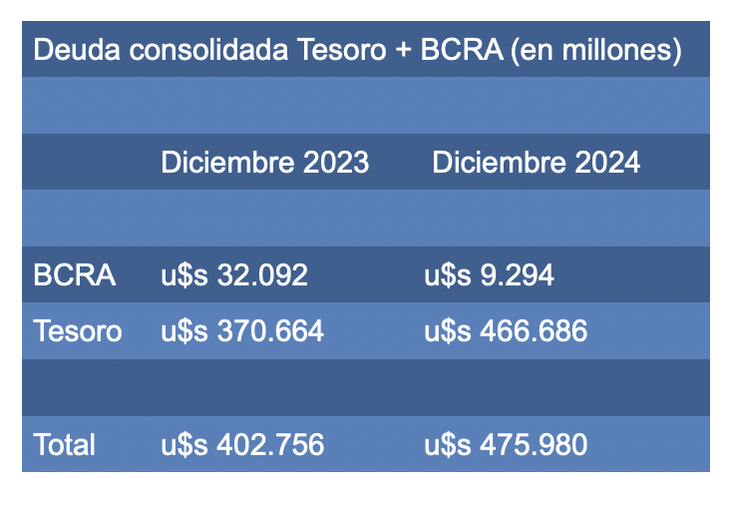In the first year of Javier Milei’s government, the debt gross total reached US$466,686 million at the end of 2024, which represents a significant increase in US$96,012 million in the year, according to data published by the Ministry of Finance in the “Monthly Debt Bulletin” of December 2024. This growth has sparked a deep analysis of the implications of debt management in a country that faces constant challenges to stabilize its economy.
Breakdown of Increased Debt
In the last month of 2024, the debt increased by US$2,446 millioncontributing to the accumulated annual growth. Of the US$464,267 million in debt in normal condition, a 55% is nominated in foreign currency.
Regarding official external creditors, such as the IMF and other bilateral organizations, the debt amounts to US$79,225 million100% of it in foreign currency. This component reinforces the need to carefully manage international relations and financial commitments due to their direct impact on the balance of payments and reserves.
image.png
The total gross debt reached US$466,686 at the end of 2024.
The total increase of US$96,012 million in 2024 it is broken down into US$16,401 million from net debt placement and US$79,817 million attributable to valuation adjustments of financial instruments.
The Relationship Between Currency and Debt
An analysis by currency shows that, during 2024, debt in foreign currency decreased by US$9,000 million. In contrast, the debt in pesos increased by 17.78% in real terms or the equivalent of US$105,000 million. This change reflects a strategy to reduce exposure to exchange risk, but also raises questions about the sustainability of debt in local currency due to the updating mechanisms and that it occurs in a context of exchange restrictions that could modify both demand and the rate. intended by the investor when this condition ends.
The Transfer of Debt from the BCRA to the Treasury
One of the most notable events of the year was the transfer of debt from the Central Bank to the Treasury. This measure sought to clean up the BCRA’s balance sheet and reduce the quasi-fiscal deficit, but it also generated distortions in the interpretation of debt figures.
box.png

The consolidated debt went from US$402,756 million in December 2023 to US$475,980 million in December 2024.
The consolidated debt, which includes both the Treasury and the BCRA, went from US$402,756 million in December 2023 to US$475,980 million in December 2024, an increase of US$73,224 million. This change highlights how financial restructuring decisions can significantly impact total debt figures.
Final Considerations: A Critical Variable for a Fragile Economy
Clearly the devaluation of December 2023 as well as the transfer of the debt from the BCRA to the Treasury It generates distortion, noise and discussion in the view of the evolution of the total Treasury debt. The analysis of the debt in the second half of 2024, once the main adjustments are completed, shows an increase of US$ 24,000 million in debt in a normal payment situation.
The total debt in 2024 has grown. This increase is partially explained by the transfer of the debt from the BCRA to the Treasury, by the instruments that adjust for inflation compared to a crawling peg that traveled well below it, the same thing that has happened with the rate although to a lesser extent and due to the capitalization of interest from instruments such as Lecaps that, although they do not directly affect the financial result, increase the stock of debt.
In a country with a structurally fragile economy, debt management is a crucial variable. Reducing debt in foreign currency is a positive strategy, not because debt in pesos is “liquefiable,” but because it minimizes the mismatch between income in local currency and commitments in dollars. However, any increase must be cautious and supported by a sustainable economic growth strategy.
The lesson is clear: responsible debt management is essential to avoid future crisis episodes and build a more resilient and sustainable economy over time.
Source: Ambito
I am an author and journalist who has worked in the entertainment industry for over a decade. I currently work as a news editor at a major news website, and my focus is on covering the latest trends in entertainment. I also write occasional pieces for other outlets, and have authored two books about the entertainment industry.




